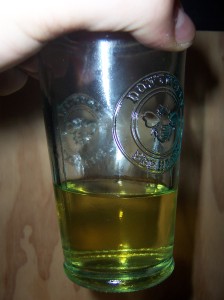The Mead Workshop yesterday at The Honey Exchange went very well! Most of the attendees were experienced beekeepers, and one of them brought his own honey from his hives to make his mead. That was great! Unfortunately I don’t have any photos of either the workshop itself or the batch of mead that I made.
One of the things I stressed during the workshop is how lucky we are in the greater Portland community to have a resource like The Honey Exchange. By far, the biggest question I get from people contacting me about mead is “where do I get good honey?” With a resource like The Honey Exchange, who not only support local beekeepers with beekeeping supplies and extraction services, but also support the general public with a wide selection of varietal and artisan honeys and honey products — including a fine selection of commercial meads — it makes things a lot easier for those of us in this area. If you have any needs whatsoever related to honey or meads, go see Phil or Meghan at The Honey Exchange and they will take great care of you.
I had looked forward to making my first batch with a varietal honey. I always use good quality local honey, but it’s usually a somewhat “typical” wildflower honey. It’s great honey and there is nothing wrong with it by any means, but it was a treat to broaden my honey palette with this batch of mead.
Star Thistle (Centaurea maculosa)
The honey I ended up using comes from Sleeping Bear Farms in Michigan. Their Star Thistle Honey is gathered from the nectar of Star Thistle that only grow in northern Michigan in abundant quantities. It truly is locally produced for them, and ships out directly to Portland.
Apparently this species of Star Thistle is native to Eastern Europe and is an invasive species in North America. It is also called Spotted Knapweed and is interesting that there have been efforts to eradicate the species, but these efforts have been resisted by honey producers in the area because of the quality of honey it produces. There is also a good argument for keeping the species active in Michigan:
Star Thistle is a non-native plant, but one that has significant benefit. Primarily, it grows and blooms at a time of the year when there is little forage for honey bees. This period typically occurs around the end of June, after clover has finished flowering, and lasts for about 6 weeks. This nectar collection is vital for the survival of the honey bees, as they are busy storing food for the upcoming winter.
Star Thistle in Michigan is a fine example of how invasive species isn’t as cut & dry of an issue as we would think. Humans have so profoundly affected the ecosystems of the planet that I think the balance of nature will have to adjust. It is no surprise to me, then, that certain non-native plants thrive in an ecosystem like this.
As far as the honey itself goes, Star Thistle Honey is fantastic. It is thicker, with a very mellow, floral, musky, flavor to it. It is lighter than what I am used to, unfamiliar to my palate, which is accustomed to sweeter and fruitier Maine honey. It’s delightful to work with, and I look forward to seeing how this mead turns out.
I used the same Mad Trad D recipe I have been using, with a chaga/sumac decoction, and added enough honey to get to a 15% initial alcohol potential for a drier mead. So this mead will be a bit drier, and also the flavor profile of the honey should be different.
Interesting to note that I did not go home immediately after the workshop, so the carboy spent about 8 hours in my car, in 30-40 degree temperatures. As such it is starting slowly. I will watch it carefully over the next 48 hours as it warms back up; I may even artificially add some heat to it. If I need to do anything technique-wise I will document it here.

As you can see the color is a bit darker than other traditional meads I’ve done with Maine Wildflower honey, but we’ll see how it settles out. Much of the dark color is due to the chaga, which does tend to fade as the mead progresses.
UPDATE: March 26, 2014

I finally racked this version, now that I have some empty jugs after the recent bottling session. This mead is already mostly clear, and is delicious! It has 1% remaining alcohol potential, so it is quite dry, and is 14% ABV. There is only a subtle hint of that young dry mead harshness, this is probably the best young dry mead I’ve done yet. It is quite drinkable already, and I’m sure it will just improve with age. It has a lovely almost tartness (sumac?) as well as a somewhat caramel-y overtone that lingers in the mouth, reminiscent of aged mead. I’m kind of blown away at how good this is already!
